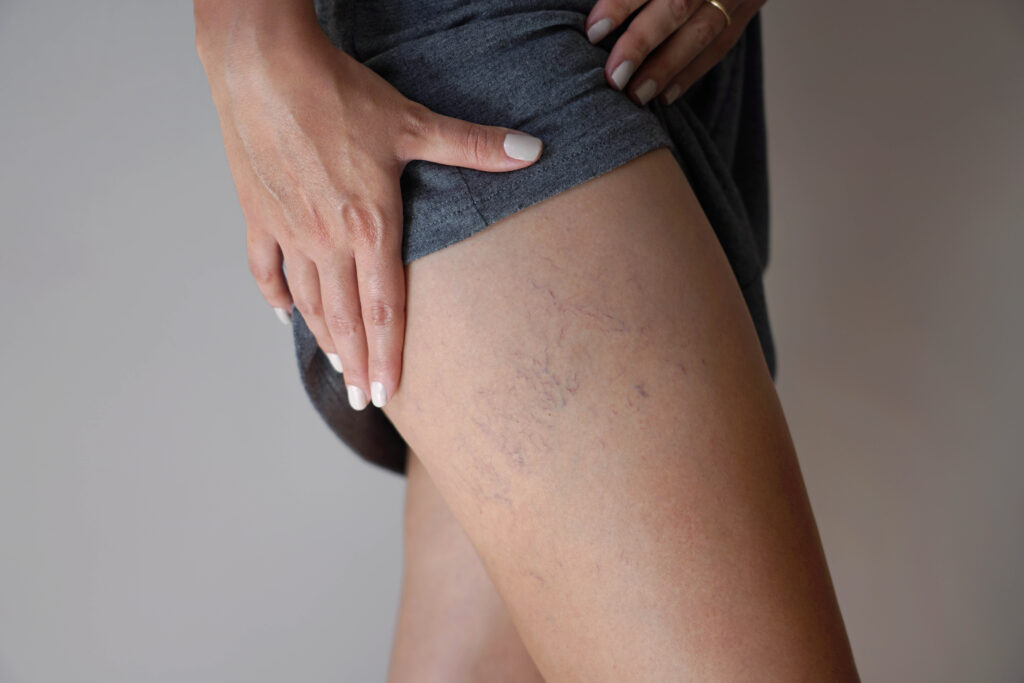
When it comes to varicose and spider veins, there are misconceptions everywhere. And if you suffer from visible veins, you may believe some of them.
Visible veins are surprisingly common and extremely complex. They can be influenced by an interesting mix of genetics, lifestyle, and health, but luckily, they’re not just something you have to live with.
Surprising Facts About Visible Veins
From busting myths to exploring state-of-the-art solutions, here are eight things about visible veins that might just change the way you think about them.
-
Varicose and Spider Veins Are Not the Same
While people commonly use the terms interchangeably, varicose veins and spider veins are distinct conditions.
Varicose veins are larger, bulging veins that often appear on the legs, but can occur elsewhere. Varicose veins are usually blue or dark purple and can protrude above the skin’s surface.
Spider veins are smaller and thinner, resembling tiny webs. They are typically red, purple, or blue, and can appear anywhere on the body or face.
Each type of vein has different causes, with varicose veins often linked to valve malfunction or poor circulation, while spider veins are typically caused by hormonal changes, sun exposure, or inherited factors.
-
Visible Veins Can Happen at Any Age
Many people assume visible veins are a sign of aging, and while it’s true they’re more common in older individuals, younger people aren’t immune.
Factors like genetics, hormonal shifts (such as pregnancy or puberty), and lifestyle habits can cause visible veins to show up earlier than expected. Younger people who spend long hours standing, lead sedentary lives, or have a family history of vein issues may notice spider veins or varicose veins as early as their 20s or 30s.
-
Visible Veins Can Cause Pain and Discomfort
It’s easy to think of visible veins as a cosmetic issue, but the reality can be much different. For many people, varicose veins, in particular, aren’t just unsightly; they’re uncomfortable.
Common symptoms include:
- A heavy or achy sensation in the legs.
- Swelling around the ankles and feet.
- Cramping or throbbing in the affected areas.
Left untreated, visible veins can sometimes lead to more serious health concerns, such as skin ulcers or blood clots. If your veins are causing pain or persistent discomfort, it’s important to seek professional care.
-
Lifestyle Can Impact Visible Veins
Many people believe veins are purely genetic, but your daily habits can significantly influence the development and severity of visible veins.
- Prolonged Standing or Sitting: Jobs that require standing (like retail or healthcare) or sitting for long periods put extra pressure on veins, contributing to blood pooling in the legs.
- Weight Changes: Obesity increases pressure on the veins, making it harder for valves to pump blood efficiently.
- Smoking: Smoking impacts circulation and weakens blood vessels, increasing the likelihood of vein issues.
Simple lifestyle adjustments, like taking breaks to walk during the workday or incorporating regular exercise into your routine, can go a long way in supporting vein health.
-
The Sun Can Make Them Worse
You might think of sun exposure as just a cancer and aging risk factor, but it can also worsen visible veins, particularly spider veins. Ultraviolet rays weaken vein walls and make blood vessels more prone to dilation and damage.
-
Compression Stockings Don’t Treat Visible Veins
Compression stockings are often recommended to alleviate symptoms like swelling or discomfort associated with visible veins. However, it’s important to know that they don’t “treat” vein conditions or eliminate the appearance of varicose veins and spider veins.
Instead, compression stockings work by improving circulation and reducing symptoms. While they’re an excellent supportive measure, other medical vein treatments are necessary to diminish the appearance of veins.
-
There Are Multiple Treatments Available
While surgery is an option for certain veins, it isn’t the only choice. Today, a wide range of minimally invasive treatments can restore smooth, healthy skin without requiring significant downtime. Options include:
- Sclerotherapy: A popular treatment for spider veins involving the injection of a solution that causes the vein to collapse and fade over time.
- Laser Therapy: Effective for smaller veins, laser treatments use focused light energy to target and seal off damaged veins.
- EVLT (Endovenous Laser Treatment): A laser treatment for larger veins where a tiny fiber is inserted to introduce laser energy directly into the vein.
- Sealants: Minimally invasive procedures that uses foam or other specially formulated compounds to close off veins.
Consulting a specialist is the best way to determine which treatment aligns with your visible veins.
-
Treatment Might Be Covered by Insurance
One of the most surprising facts about treating visible veins is that some procedures may be covered by insurance, especially if they’re classified as medically necessary rather than purely cosmetic.
For example, if varicose veins are causing pain, swelling, or other symptoms that interfere with daily life, your insurance provider may consider covering part of the treatment cost.
Take Control of Your Vein Health
Visible veins may feel like a permanent problem, but advancements in treatment options mean they don’t have to define your life or your appearance. Whether you’re dealing with spider veins, varicose veins, or discomfort, there’s a solution that can restore your confidence and your comfort.
Schedule your consultation today, and find out more about visible veins and treatment options!